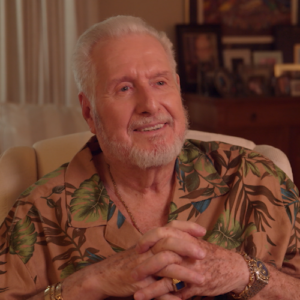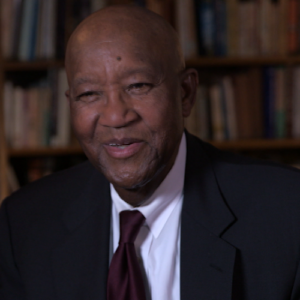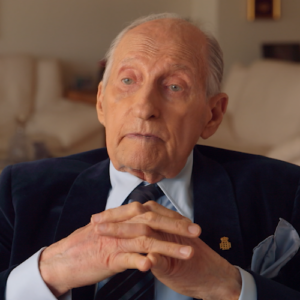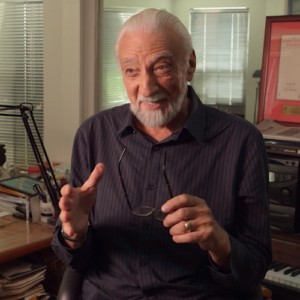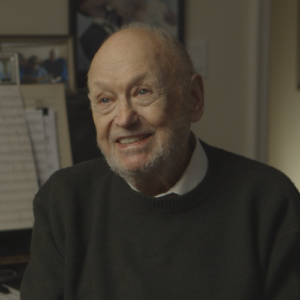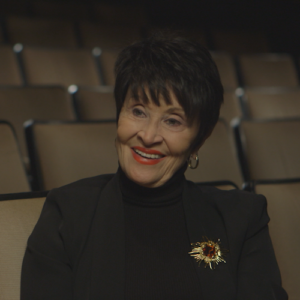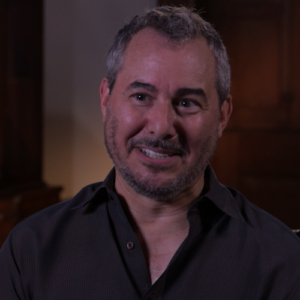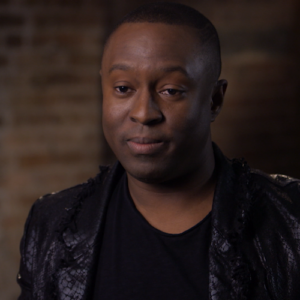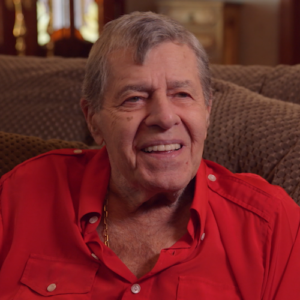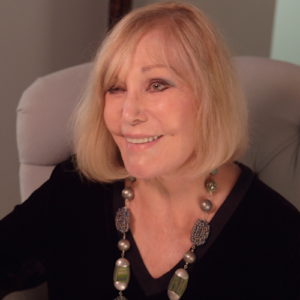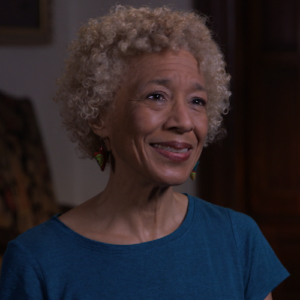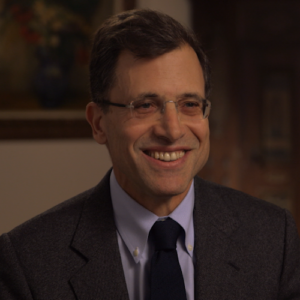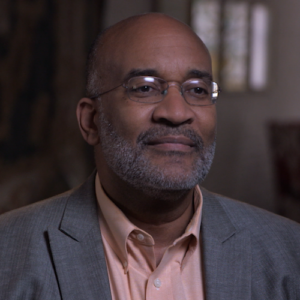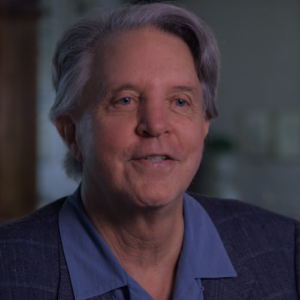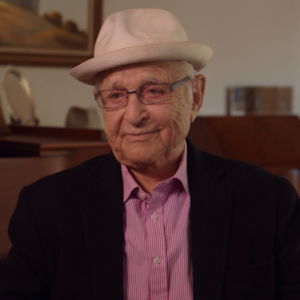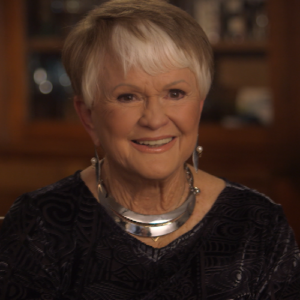Claytee White: My name is Claytee White. I am the director of the Oral History Research Center at UNLV Libraries. And today we’re in the reading room in special collections at university libraries. This is lead library. Special Collections is the area that collects the written oral. Video. Images of life in Las Vegas, southern Nevada.
Interviewer: Yes. We are in the right place. How does Las Vegas change in 1931?
Claytee White: So in 1931, Las Vegas really legalized gaming. We started the building of Hoover Dam. And changed the laws related to divorces and I believe marriages. But divorce is definitely we changed that waiting period to get a divorce, shortened it. So 1931 major changes also started the construction of a federal building that is now the Mob Museum. But at that time, it became the post office courthouse. And I mention that because that was the first African-American community. So at that time, blacks were asked to move out of the downtown core and to move across the tracks.
Interviewer: The big casinos get built in the mid to late forties. What was the role of the black citizen in Las Vegas at that time?
Claytee White: Mid to late forties. I would rather tell you about the early forties.
Interviewer: Please.
Claytee White: Because that was the great migration of blacks to Las Vegas. So the World War Two migration brought African-Americans to Las Vegas probably in greater numbers than any time, any other time in history for that short period of time during the World War Two era, we had jobs here related to the war industry. So blacks came from small cities like Fordyce, Arkansas, Tallulah, Louisiana, small places in Mississippi to work at all of this industry. Of the major one was Basic magnesium Incorporated. So basic magnesium process, the magnesium to build bombs, bullets, airplanes for World War Two. Some of those jobs were very menial, kind of dirty kind of jobs. And black men were recruited to work in some of those jobs. So they came here in great numbers. So those photographs you see of the West side were taken at about that time because building materials were in short supply. So they put up tech shacks, tents, anything they could so that they had a space to live because they had money, they had jobs, but they didn’t have time to build housing. So that’s why you see the shacks and tents in the west Side.
Interviewer: Well, those photos were taken by Sammy Davis Jr when he was performing here. Why did he have to stay in Riverside?
Claytee White: Because Las Vegas, like a lot of cities across the country during the 1940s, when Sammy Davis Jr. First started performing here in Las Vegas, I think that’s when he first started. It’s possible that he came early on as well. But in the 1940s, Las Vegas was segregated just like most of the South. You know, we’re sort of the Southwest. Well, we fit into that same mode, African-American entertainers, and they came here in great numbers to entertain Lena Horne, Nat King Cole, Sammy Davis, Jr. They could not stay in those hotels where they were performing. And we were talking about hotels like the sands, the desert in the desert. And so we’re talking about late, late forties, but mostly the fifties. Integration did not take place until 1960. So Sammy Davis Jr was staying at rooming houses on the West Side because he could not stay at the dance at the Sands, the Dunes and those other places.
Interviewer: El Rancho and the Flamingo. Did they have official segregationist policies? If so, what were those?
Claytee White: All of them have the same policies and probably nothing in writing. In writing? Wow. I can’t even talk today.
Interviewer: No problem.
Claytee White: Probably those hotels of the Flamingo Ranch at El Rancho are the frontier. They didn’t have a written policy, I’m sure, but it was just an unstated policy across the country at that time. Blacks and whites did not mingle in certain settings, so Las Vegas was the same way. We had lots of migration here. We had lots of gamblers coming here from the South Texas millionaires. So we catered to that many. So African-Americans lived in certain segregated areas of the city, and other communities were composed then of whites, and we had very few Latinos at that time. We had some Asians, but mostly our whites controlled the city and then African-Americans in the small West Side community.
Interviewer: What were the booming conditions that Santa would have found in the West Side?
Claytee White: So on the west side, at that time, we had rooming houses, boarding houses. There were several, not just the one that we know so much about because Sammy Davis writes about it in his book. There are several others as well. But the one that Sammy Davis writes about in his book was called The Harrison House, which is still there today, was just put on the National Register of Historic Places last year, night 2014. So he would have found when he walked into that rooming house, he would have found a small living room where he could sit during the day if he wanted to, to write letters, to engage with other people rooming there. He would have found a kitchen, a kitchen and a dining room, and then small rooms throughout the house that were rented to people traveling. Not just entertainers, but all African-Americans traveling through the city, had a small yard in the front, and that yard was especially used by people like Nat King Cole to go out into the yard and smoke. So we have interviews with people, with children at the time who would walk and walk up and down the street and to Nat King Cole would come out of the house and they would engage him in conversation. So because of those kind of interviews, we know about the people who stayed there. We knew about Sammy Davis, we know about Pearl Bailey and staying in those small rooming houses.
Interviewer: Will. Marcin complained he was overcharged on the website. Can you tell us about that?
Claytee White: Well, I read about that in Sammy Davis book. I didn’t realize that they were overcharged. I think that Mrs. Harrison was a businesswoman. She was supposedly a very, very good businesswoman. And she knew that she had a captive audience. So just like a good business person, she took advantage of that audience. Also, she knew that some of those entertainers were earning more money than she would earn in a year. They would earn that in a week. We have evidence of that when we look at what Nat King Cole earned at the Sands. So, of course, she knew what they could afford to pay her. And even though there was a joke that said something like, Wow, this is what I would pay at the Sands. And Mrs. Harrison said something like, Then why don’t you go to the sands? Well, they couldn’t go to the sands. They had to stay at places like Mrs. Harrison. And she wanted to make money. Just like the Sands.
Interviewer: The Harrison house is still standing.
Claytee White: Yes, it is still standing. And I can take you to it if you’d like to see it.
Interviewer: Oh, shoot. They just got along.
Claytee White: The Harrison house is now. 501 See three just put on the National Register of Historic Places and it is being used for lots of programing for that West Side community cleanup days and all kinds of other plans affect for that house. When Sammy Davis Junior would come to Las Vegas to entertain, he could not stay at the sands at the desert he had. Later on some of the other hotels, he could not stay there. He can stay at the El Rancho. So he would have to travel across town and he would stay in a community called the West Side. One word, the West side. It was the African-American community that was housed that housed the African-American community, but it was the African-American community that had restaurants, nightclubs, rooming houses, boarding houses, several of them. We know the Harrison House very, very well because it is still standing today.
Interviewer: That’s excellent.
Interviewer: And also, you set up, Mark, that Sally took pictures of it. Can we have Clay tell us that? We can see some of that through his pictures?
Claytee White: Oh, yeah. The Sam attic picture of the Harrison house.
Interviewer: I don’t know about just the West Side. Oh, yeah.
Claytee White: I can show you photographs of that West Side community, just like those photographs that Sammy Davis took of that area when he was here. Camera buff. Buff. So I can show you some of those same photographs in our collection. So that’s what we do here in special collections.
Interviewer: Fantastic. Sammy first performed in Vegas Central Rancho in 1947. How many other black performers would have come to Vegas by then?
Claytee White: Other entertainers would have come early on as well, some not as well known as Sammy Davis. Some of those names I can share with you don’t have them on my cheat sheet. But later on, like 1948, Lena Horne was here already because she was one of those opening entertainers at the Flamingo. Her husband, she and her husband knew Mr. SIEGEL. And she was one of those early, early entertainers at the Flamingo. Some of the early performers who performed in Las Vegas were people like Pearl Bailey. But Pearl Bailey performed here even earlier than most because she performed here before there was an El Rancho, before there was the Flamingo in the late forties. She performed here in the early forties downtown at some of those casinos. So we have a long tradition. We have pictures of billboards showing some of those early African-American entertainers.
Interviewer: Nice. Why did black performers refer to Las Vegas as lost wages?
Claytee White: I am not sure that the entertainers refer to Las Vegas as lost wages. Probably because some of them gamble some of the money away as soon as they earned it. But they earn more money in Las Vegas than they did most cities in the country. So even when segregation was harsh here and they could not stay at the places they performed, they continued to come because the money was so lucrative. We find that in the biography of Lena Horne. Lena Horne was one of those who were. She was just very concerned. Very. Uneasy about performing in Las Vegas because of the severe ness of the segregation here. She could perform in other places. Yes, and there might be segregation. But the housing for her, even in African-American communities, were a lot better than the housing we had here in the African-American community. But she continued to perform because the money was so good. And I have a feeling that that’s why the Will Mastin Trio started here very, very early performing here. And that’s why Sammy Davis Jr continue to perform here years and years. And of course, later in 1960, he becomes a part of the Rat Pack. So then, of course, he was here all the time.
Interviewer: I’m going to get to the Rat Pack. Yes. This talk about the hypocrisy of the casinos, hiring black entertainers such as Sammy to be attractive and competitive? We are treating them like second class citizens.
Claytee White: And so the Las Vegas casinos did not allow black entertainers that they hired to perform on their stages, stages that brought in people from all over the country. Brought in the Hollywood elite. And then they would ask those same performers not to stay in those hotels. So, yes, is that hypocrisy or is that just America at that time? So we know that blacks and whites were segregated all over the country at that time. We can think of isolated places where there was integration early, but most of our businesses, our entertainment, our churches were not integrated establishments. So I don’t expect Las Vegas to have any different. Accommodations than anyone else. And I think that we were harsh because our funds, our moneys came from wealthy gamblers all over the country, especially oil men from Texas. So we cater to that crowd. I’m not making any excuses. I think it was horrible. But yes, black entertainers were not first class citizens. Black entertainers were not treated like the white entertainers, the named white entertainers of the day. Jack Benny did not have to stay on the West Side. Jack Benny could stay anyplace. But Sammy Davis and other entertainers. Didn’t have those privileges. We did not have public accommodations.
Interviewer: That was incredible answer. Here’s a Sammy quote. In Vegas for 20 minutes. Our skin had no color, and the second we stepped off the stage, we were colored again. Other acts could gamble or sit in the lounge and have a drink. We had to leave to the kitchen with the garbage.
Claytee White: That’s exactly right. Las Vegas was harsh. Las Vegas was a town where tourism. Was the. The industry just like it is today. That is the industry that kept Las Vegas alive in order to have those tourist dollars. Las Vegas had to appease the people, bringing in the fans, bringing in those dollars. And those people were white. So they did not want the black entertainers seen in the presence of the white tourists so they could not sit in the lounges. They could not gamble in the casinos. So that meant that they had to enter the establishments through the kitchen. Most of the time they could not even eat in those places. There were one or two restaurants on the Las Vegas Strip that actually allowed black entertainers to eat. One was foxes. So black entertainers could eat there. But that was about the only place that they could really go in and sit down and eat. Otherwise, they were back in the kitchen. Now they were standing out by the pool. Where they could not swim. So we have many stories about black entertainers. Jumping into the pools Now, we have so many of those stories that we don’t know which one to believe. We know that someone jumped into a pool and the pool was drained. But because the story has been told so many times now, I’ve heard it as Dorothy Dandridge, Lena Horne, Sammy Davis, Jr. And I believe Nat King Cole. I don’t know who actually jumped into the pool and the pool was drained, but supposedly it actually happened. I don’t know what it is about blacks and water. So I don’t understand that.
Interviewer: Yeah. That that is such a. Subjective, an awful thing.
Claytee White: Yes.
Interviewer: You have to drain the water.
Claytee White: Yes.
Interviewer: How did it how did Jim Crow end in Vegas?
Claytee White: Las Vegas, Believe it or not, after all of the harshness of segregation in Las Vegas, integration really began to end early on March 26th of 1960. Integration on the Las Vegas Strip and the downtown hotels in it. We had our first. Professional dentist first dentists in Las Vegas. James Macmillan was president of the NAACP at a time when the national CPR asked their branches across the country to. Do something about integration in all communities. Dr. Macmillan decided that it was time to integrate Las Vegas. So he wrote a letter to the city, to the mayor, the city Council. That if by March 26 he wrote the letter about three weeks earlier, he said if by March 26, 1960, the Strip is an integrated, we are going to stage a protest on the strip on a Saturday night. March 26 was the Santee. It was also the night, I believe, of a major prizefight. So because of that threat, conversations started a dialog started between the. Leaders in the black community, the mayor of the city, Hank Greenspun, who was publisher of one of the local newspapers, The Sun, and some other people. So the conversations were heated over this three week period that they went back and forth. Threats were made against Dr. MacMillan’s life, but in the end. Hotel owners decided that they would integrate. We know it had to start at that level. But that Saturday morning, March 26th, everybody sat down in the Moulin Rouge. Now, the Moulin Rouge heyday had already ended. We’re talking about 1960. Their heyday was 1955. Heyday had ended, but the place was still open for business. Not the same level of business, but it was still open. So everybody set down in that casino. On that morning, the mayor of the state. Sorry, the governor of the state, the mayor of the city, The editor of the owner, publisher of the newspaper The Sun. Black leaders, including the president of the C, but several others were around the table. The police chief and several of the people all sat around the table and they hashed out the agreement. It’s called the Moulin Rouge Agreement today, but it was not in writing. It was a verbal agreement that ended segregation in Las Vegas. So they agreed that that night the black community would test to make sure that it was going to hold. So black couples, instead of marching down the strip as they had planned to do, they went into all the casinos up and down the strip and downtown. And it held except for two or three locations that would not allow blacks in to gamble. But every place else it held in 1960.
Interviewer: Were there a lot of blacks working at the casinos? If so, what capacity?
Claytee White: In March of 1960, when integration took place. We had lots of blacks working on the strip and downtown. They were all in the black in the back of the house. They were all invisible. They could not cash the checks in the casinos. They were leaving by the back doors as well. So that was a and they were members of the Culinary Union. So those jobs were mostly African-American jobs, the maids and then in room workers, porters, even though we could see porters cleaning around the casino floors. But we still kind of consider them invisible. So those all of that work went on in the back of the house. We call it the back of the house, and that’s where that work went on. But we’re very encouraged by that because not only was that the foundation of blacks working in the casino industry, but because we had a culinary union here that allowed black membership early on and it was good representation. Because of that, those black people migrating here, starting with the World War Two migration could then buy homes, especially after the war, when building materials became available. They could buy homes. They could send their children to college. And I would say that they could buy cars. But we could always back cars. And people complained today because those pictures that Sammy Davis Junior took on the West Side, where you saw the tents and the shacks. Well, people complain because in front of those tents and shacks, we have Cadillacs. Blacks could get a loan for a Cadillac. You could not get a loan for real estate.
Interviewer: Those workers at the casinos with Sammy have franchised with him what he would. How would how would the interaction go down between them?
Claytee White: When Sammy Davis Jr. Was entertaining here before integration and he was staying on the West Side, the African-American community had a benefit that we never think about. Those black entertainers lived on the West Side. Sometimes it would mean they are on the west Side for two weeks at a time, for weeks at a time. They’re sitting at boarding houses, eating at restaurants and going to jam sessions in the nightclubs on the West Side. So Nat King Cole, Pearl Bailey, Sammy Davis, Jr, you name them. And black. The black community all stretched all levels of the black community. We’re talking about workers, blue collar workers. We’re talking about pink collar workers. We’re talking about professionals. They rub elbows with all of those entertainers in a very intimate setting, not just in an audience at the Sands. But we are talking about at the Brown Derby. We we’re talking about at the Town Tavern or other little nightclubs on Jackson Street on the west Side, where they would come after performing on the strip. And there was one place on it over there that with that people tell the story. Now. They had the champagne glass already chilled for Pearl Bailey. So when she walked in her champagne glasses ready and they could pour her drink for her. So they got to know them very, very well. Not unusual for Nat King Cole to sit down and play the piano. And then for jam sessions to go on until the wee hours of the mornings.
Interviewer: It sounds like on the west side that those establishment that that’s where things got real.
Claytee White: Exactly. Exactly.
Interviewer: You want to explain how real it got?
Claytee White: Now, I don’t know that answer. I don’t know that answer.
Interviewer: If will to the Rat Pack of Old Vegas.
Claytee White: So the Rat Pack probably started around 1960. The first Ocean’s 11, I believe, was 1960. We sometimes say the Rat Pack started in 1959, so probably they probably came to to even start getting ready for the filming at that time. So I think the Rat Pack had an influence. I don’t think it was as great as the influence that we think today. Yes, those guys had a lot of fun. We can look back at some of the footage and we can look at Dean Martin and Sammy Davis Jr and Frank Sinatra and and other guys, Joey Bishop and other people. I forgot one name, but other people. Peter. Peter Lawford They had wonderful, wonderful, great times on the stages at places like the Sands. And it was said that. Frank Sinatra made the decision that he wasn’t going to stay at the Sands any more unless Sammy could stay. So I have a little problem with that because 1960 March of 1960, Sally could actually stay at the Sands. So I’m not sure how that played out. Maybe Sammy wasn’t allowed to gamble until later on. I’m not really sure about that, but I doubt it. Seriously. One of the things that when integration was tested March 26, 1960, African-Americans could go in and gamble. Now, 1950s, it would make sense that Sammy Davis Junior could not go in. But the Rat Pack had lots of fun, and the Rat Pack did things that other entertainers did not do. They became. They put Las Vegas on the map in a way that Las Vegas had not been on the map before. First, it wasn’t a person just there singing a few songs and telling a few jokes. But these guys would go on. It wasn’t just a 60 minute show, a 90 minute show. They would go on. They sincerely liked each other. People want it to be in the in the crowd. People from Hollywood would come in except in exception on numbers because they want it to be there on the front row. Marilyn Monroe, all of these other entertainers from Hollywood would want to be there. It meant other people wanted to be with them. One of the things that happened with the Moulin Rouge is that people like that would want to leave and go to the Moulin Rouge. 1955 because Sammy couldn’t stay at the Sands. So if Sammy happened to be here and Frank and anyone else he knew happened to be here, they would go to the Moulin Rouge with Sammy. So that meant that even before the the Rat Pack. That they would take people from the strip to the Moulin Rouge to have fun and to party. So, yes, they had a lot of influence on entertainment, on tourism. People want it to be in the crowd. They want it to be part of that Rat Pack.
Interviewer: Who’s your favorite member of the Rat Pack?
Claytee White: Sammy Davis Junior. Sammy Davis Jr is my favorite member of the Rat Pack because he’s the most talented member of the Rat Pack. He could act, he could dance, he could sing. He could move. He could. He could do anything. So for him not to have that recognition, that scent that Frank Sinatra has had all the years, it bothers me greatly. He had when when entertainers when I interviewed entertainers who played behind the Rat Pack. Any member of the Rat Pack or all members of the Rat Pack individually, they tell me stories about Sammy Davis, how his parties were better. His gifts at the end of the engagement were better than any other entertainer. So not only was he the greatest entertainer of the Rat Pack, but he was also that person who knew how to give, probably to his own detriment. But he knew how to give and he knew how to treat people. You don’t hear him being in a fight with somebody in a hotel and having his teeth knocked down. That was not Sammy Davis. Sammy Davis was the was was a gentleman. And then he supported the civil rights movement nationally. Need I say more?
Interviewer: He was a spy. Almost a silent financier.
Claytee White: Exactly. Exactly.
Interviewer: Because people don’t know that.
Claytee White: Okay.
Interviewer: Okay. Behind the civil rights. Okay. Talk about.
Claytee White: That. Yes, we can. Okay. So Sammy Davis Jr not only supported the civil rights movement, meaning that he supported it with his being, with his body, being there to march in some of the marches. Sammy Davis Junior supported it financially. We always think of other black stars having financially supported the movement. But Sammy Davis supported it silently. We’ve heard the other names associated with it. Sammy Davis didn’t even need that kind of recognition. He did it silently and he put his body on the line.
Interviewer: Okay. A lot of people don’t know about Moulin Rouge.
Claytee White: Okay, good, good. Let me let me talk about the Moulin Rouge.
Interviewer: All about it.
Claytee White: So this is going to be rather long because I like talking about the movie. So in 1954, we began to have a professional class. Move into the black community from across the country. And what I mean by professional class is we got our first black doctor in 1954, first black dentist in 1955. In 1954, when Dr. Charles West moved to Las Vegas, we also got the first nice housing development for blacks adjacent to the West Side area. It was called Berkeley Square. So our first black doctor, our black performers and entertainers and professionals moving in to work at the Moulin Rouge had a place to live. They can live in Berkeley Square. So as Berkeley Square is being constructed, so is the Moulin Rouge. The Moulin Rouge is built on a a street Bonanza Avenue. It’s really not in the black community, but it’s only about two blocks away. So it’s adjacent to the black community. The Moulin Rouge was the first integrated hotel casino that could rival any place on the Las Vegas strip. So just as posh, just as plush as the sands, the desert in the dunes Dunes opened that same year. So we are talking about that level of establishment. And it is in the black community almost. So the first integrated place that allows blacks now to see. A show. In an arena that is where they can order champagne. Where they can have fine dining next door in the same hotel where they are greeted by Joe Lewis, who is the greeter of the Moulin Rouge. Now, unfortunately, the establishment was white owned. It is possible that Joe Lewis owned a 2% interest. It is possible, but we can’t prove it yet. So that night, that opening night, we have Hollywood stars mingling with people from the black community, professionals, blue collar workers. They’re all there dressed in all their finery in this place with great entertainment. The Platters, who at that time had a hit record. They are one of the opening acts. We have a line of black dancers. That is the first line in the city. And these are dancers who have danced all over the world London, Paris, Los Angeles, New York. And now they’re all in a line together dancing in Las Vegas. We have. A restaurant where we have black waiters in tech, CEOs in white glass. The wallpaper is the image of the Moulin Rouge in Paris with dancers doing the cancan. So that is the place that you enter. In May of 1955. And it’s the first time that blacks can do this in this town. Now, the heyday was only five and a half months, and it’s over. It is padlock. It is in bankruptcy. And there are many reasons for that. Number one, some of the bills were never paid, so some of the subcontractors were never paid for the construction work that was done. And while that might be true, the story that I like to tell is that it was too much competition for the hotels like the Sands and the Desert Inn, because everybody wanted to be. In a place where all their friends could go. So it meant that if Sammy Davis Junior happened to be in town, everybody could go with him and party with him at the Moulin Rouge, where now he can stay in a place that’s upscale. He doesn’t have to worry about staying at a boarding house anymore. He can stay in one of the rooms at the Moulin Rouge. So the Moulin Rouge really changed. The era was a great change for the city.
Interviewer: This is a nuance that that I’m inferring. But maybe you could clear it up that Las Vegas respected to America may have been better in terms of Jim Crow until the casinos wanted entertainment. And actually, it was worse for.
Interviewer: Performers.
Interviewer: Because of this this what you mentioned, this sort of this Jim Crow that the white gamblers, the clientele didn’t want to associate with with black people. Do you think it got worse because of that for a period of time?
Claytee White: Okay.
Interviewer: But they impose something that wasn’t there.
Claytee White: So it is said that early on. That everybody in Las Vegas got along, that the city was really integrated early on. So Las Vegas is a city that started in 1905. And it started with blacks living in a special community. The city was run by the railroad. Las Vegas is here because the railroad needed a place to stop between the Los Angeles area and Salt Lake. Salt Lake. Lock. And Salt Lake City. Okay, so Las Vegas is here because the railroad needed a place to stop between Southern California. And Salt Lake City. Las Vegas was the place chosen because we had water bubbling up from the ground. So Las Vegas had an icehouse. That meant that the trains could be referred refreshed. Here in Las Vegas, water ice could be put on the train for any good that happened to be going back and forth. So that’s why Las Vegas is here. It was a railroad town. People came here to work on the railroad. Blacks came here along with everyone else for jobs on the railroad. The person who was in charge of the town who controlled the water and worked for the railroad was call was named Walter Bracken. Mr. Bracken asked African-Americans to live on Black 17. Black 17 is adjacent to Black 16, the Red Light District. Blacks live in that community, whether they had to or not. May not be whether they really was forced to and not we can’t not we cannot say they were asked to live there and it’s where they lived. So they lived in black. 17 is where they had their businesses. It’s where they had their homes. And in night in the late 1920s, that community was asked to start thinking about moving across the tracks. They wanted blacks to move across the tracks because we were expanding downtown. Now. Yes, other communities were beginning to move out of downtown as well because businesses were expanding. So in the late 1920s, early 1930s, we have the white community also moving into developments. Where blacks could not live because of covenants, racial covenants. So blacks moved into a special neighborhood that was called West Las Vegas that eventually became known as the West Side. So even though we say that. Race relations were very cordial and congenial in the early days. It’s possible that it was, but from the evidence that I see. I don’t think it was ever as congenial as it could have been. That blacks, still black women, worked in white homes cleaning those homes. They did laundry. They took in white laundry. That’s what black women did for a living. Black men worked on the railroad along with white men. And I don’t think there was any differences in the job categories. I don’t think. But they live in separate communities. And black women did different work than white women. So as things began to change, as gambling became our major industry. Downtown was known as a place that was integrated. We know that Pearl Bailey entertained early on in that downtown court corridor. So before the Las Vegas Strip. Began. Whites and blacks. We’re mingling together in some of those hotels downtown. I don’t know the extent, but they could gamble because we know that Pearl Bailey, actually. Gamble downtown. So we actually read about that. So we know that that was possible. I don’t know how that changed. I don’t know when that changed, except in 1931, when we had the influx of more and more workers to work on the Hoover Dam. Hoover Dam workers came here to work on the Hoover Dam. Boulder Dam, we call it today. There was a federal community construct, it called Boulder City. That federal community did not allow whites to live there. Excuse me. Wow. Woo!
Interviewer: Woo!
Claytee White: So in Boulder Dam, blacks could not live. Blacks had 40 of the 20,000 jobs on the dam over the four year process of building the dam. So I see harshness all along. But I do see an integration downtown in that downtown corridor. That I did not see later on in Las Vegas history.
Interviewer: And they also.
Interviewer: A number of you. You’re obviously very well versed in the Rat Pack. The Rat Pack brings like different feelings from people, especially in terms of Sammy’s role with Frank. Do you have any thoughts about that?
Claytee White: The Rat Pack. Was an entertainment force in Las Vegas. It was headed by Frank Sinatra. He was the chairman of the board. He led the Rat Pack. I never really appreciated all of the antics. There was one of the jokes about the city and. Dean Martin picks up Sammy Davis Junior and said, This is my trophy. Something like that. But those jokes are not funny to me. But though that was the Rat Pack. Sammy Davis wanted to be a part of the Rat Pack. He just wanted to be there. He values that friendship with Frank Sinatra. And I think the friendship with Frank Sinatra, probably. Helped his career at a time. When there are forces that he could not control. I think Frank Sinatra made some of that better for him at a time when black entertainers were not always valued. And I think he respected Frank Sinatra for that. But I think he loved just being in the in the group. I think he loved being with them. I think their families liked each other. I think they interacted in Los Angeles as well as here in Las Vegas. Dean Martin’s daughter tells stories about getting to know Sammy Davis Jr. So we know that they interacted there in Los Angeles at the same time that they were interacting here in Las Vegas. I think it was prestigious to be around Frank Sinatra in Frank Sinatra’s heyday. And I think that was one of those times when Frank Sinatra was in his heyday and Sammy was was allowed to be in that group. I think that’s how he felt about it. I don’t think it was necessary for him to have to feel that way. I think they needed him as much as they needed Frank. I think they needed that talent. I mean, who else could dance like Sammy Davis? So I think they needed him as much as he needed them. So I think there was probably a balancing there. But I don’t I don’t know if Sammy Davis really knew how valued. He was and how valuable he was.
Interviewer: Sammy’s. Sammy’s accident happens when he’s coming out of Vegas. And I was just wondering if you can speak to you know, Sammy essentially is a nightclub performer who then expands to all these other things and just link Sammy. And Vegas with that accent that it’s not surprised he’s in and out of Vegas all the time. He’s driving in the frontier. He’s leaving the frontier that day.
Claytee White: He’s so Sammy Davis Junior has an accident in 1954. I believe he’s leaving Las Vegas. He’s driving to and I think he reaches someplace like San Bernardino and he has a horrible car accident that really causes him to to lose his eye at that time. And he’s in the hospital for quite a while. We’ve heard lots of rumors surrounding that car accident, but I think he was probably just tired and he was probably driving a car. And that that is a lonely drive. Even today, when we are allowed to drive 75, 80 miles an hour, it’s a long drive. I don’t know who he was in the car with. I think it was alone, but I’m not sure. I think he was alone that day, that it’s a very long, lonely ride when you probably don’t have CDs or cassettes to play like we have now. We can’t read. We can’t listen to a book on tape. He couldn’t listen to a book on tape at that time. So he was driving tired and he had a car accident. And I think that was the extent of it. I don’t think anybody caused the accident other than he had an accident in the car. He lost an eye in the accident. And I think it was very traumatic. And I think that was at the time also that he was involved in a conversion to Judaism. And so so I think he was in a good place mentally because there is a philosophy, a way of life that is a very uplifting, positive philosophy. And that’s what I think he was going through at the time. So I know that he also was I think he was dating outside of the black race at the time. And someone had said that maybe that had something to do with the accident. But I really don’t think that’s the truth. I think the truth is that Sammy Davis Junior had a horrible car accident and that it happened at a time in his life that he was a wonderful entertainer and that he used that as in a very, very constructive way. He even used the eyepatch for a while there, and it was just very rakish looking there for a time. So so I think he was even though he lost the I think it was one of those experiences that happened. Because of his career.


